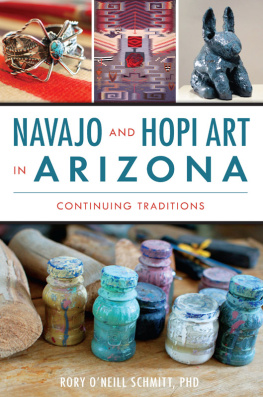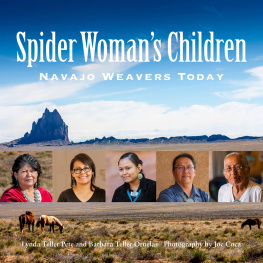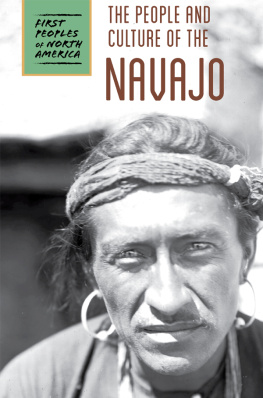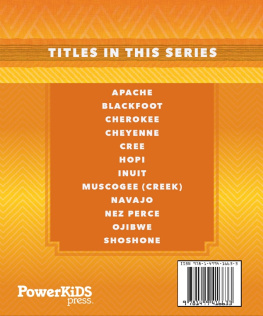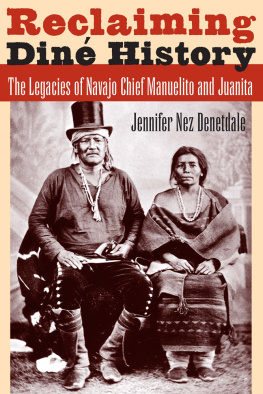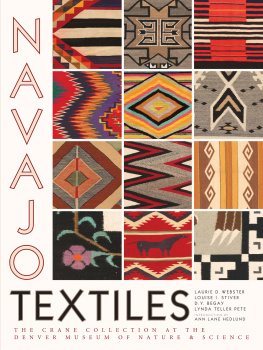


Published by The History Press
Charleston, SC
www.historypress.net
Copyright 2016 by Rory ONeill Schmitt
All rights reserved
Front cover, top left: Spider Woman by Edward Charlie. Photo by Rory ONeill Schmitt (2015), all rights reserved; top center: Winter Apparition by Marlowe Katoney. Courtesy of Marlowe Katoney, all rights reserved; top right: Blue Yazzie Sits at the Ganado Post Office by Melanie Yazzie. Courtesy of Glenn Green Galleries, all rights reserved; bottom: Artistic materials for Manuel Chavarrias katsina doll carvings. Photo by Rory ONeill Schmitt (2015), all rights reserved.
First published 2016
e-book edition 2016
ISBN 978.1.62585.560.2
Library of Congress Control Number: 2015955718
print edition ISBN 978.1.46711.789.0
Notice: The information in this book is true and complete to the best of our knowledge. It is offered without guarantee on the part of the author or The History Press. The author and The History Press disclaim all liability in connection with the use of this book.
All rights reserved. No part of this book may be reproduced or transmitted in any form whatsoever without prior written permission from the publisher except in the case of brief quotations embodied in critical articles and reviews.
This book is dedicated to my husband, Dasan, and to our daughter, Olivia Rose.
I love you both tremendously.
CONTENTS
FOREWORD
Navajo and Hopi Art in Arizona is an engaging collection, indeed, a complex weaving of artistic journeys presented by author Dr. Rory ONeill Schmitt. Rory invites the reader to best appreciate these journeys by providing a brief foundation of pertinent history, gained from literature and primary sources, related to the arts of the Navajo and Hopi tribal communities. Drawing on her unique education and practical experiences as author, art therapist, educator and professional photographer, Rory next vividly introduces us to several contemporary artists who share their lives and artist journeys. Parallel to these artists life stories, Rory reveals her own journey of awakening to a far better understanding of native arts, an awakening that evolved into a commitment to lifelong learning regarding the fascinating and ever-changing topics of native arts. Whether you are already well grounded in native arts or a novice on the topic, this book will further provide an invitation to all readers to begin or refresh a similar personal journey.
The substantive weaving of content and journeys in Navajo and Hopi Art in Arizona is crafted to engage and challenge all readers. Fortunately, the collective wisdom shared by the artists whom Rory has selected provides guidance to maximize our reading and resulting life experiences. There are some frequent themes to keep in mind as the informational levels unfold.
Read and listen carefully to the stories and voices of the artists. I found myself returning and reading again such passages. Ramson Lomatewama (one of the Hopi artists selected) urges our attention to native voices in his poem Words of Wisdom. Listen!
Absorb my words into your heart
As our mother the earth
Absorbs the summer rain.
Appreciate the many relationships and shared values among the chosen art media, styles and forms. As Melanie Yazzie sought advice regarding her choice of art over weaving traditions of her family, her grandmother said, You are weavingin a different wayweaving your ideas and stories in this new way. Ric Charlie observed, Art was artanything I could do with my hands and be creative about it falls into the category as art.
Recognize the strong influence of landscape/environment in all native art. The sky, horizon, earth, wind, rain and sun consistently emerge throughout the native art forms. Melanie Yazzie assists our understanding again as she expresses this key influence in a few words: I need to see the sky. I need to see the mountains.
Celebrate the power of family reflected in both traditional and contemporary native arts. Artists repeatedly refer to the strong role of family, especially as artists experience life in two worlds. Navajo weaver Barbara Teller Ornelas is a proud part of seven generations of weavers. In speaking about her choice of transition between a business career and art she stated: I was already an artist. My art is learned from generation to generation My art is passed down in my family.
Contemplate the sometimes less-than-visible but nevertheless vital roles of the mind and spirituality. Weavers are especially open about the spiritual aspects of the weaving process. Barbara Teller Ornelas notes, when speaking about Navajo woven art, They have no blankets or rugs without spirits in them. I had to learn to be calmbecause sometimes your weaving will take on how you feel or your attitude. Several artists, including Melanie Yazzie and Jesse Monongya, refer to the role of dreams in determining life direction and in their creative processes. In Ramson Lomatewamas poem The Dawn, he reflects on the confluence of sky and dreams: The Stars were made to be dreamsMysterious and eternal.
Like Fred Katbotie and Charles Loloma, several of the artists featured in Navajo and Hopi Art in Arizona in time bring their artistic journey to a point of reflection, influence and teaching. Although young, Navajo weaver Marlowe Katoney wants to support change by transforming expectations regarding contemporary art forms. Likewise, Hopi glass artist and poet Ramson Lomatewama is an educator who believes that, through art, people gain a greater appreciation of the world around them, better responding to their environment and reflecting on their spirituality: To me the artwork and what it does for a persons growth on the inside is more important than anything else. As we assess our own personal artistic journeys, such lofty stages might seem a challenge, but we can take comfort from a native blessing:
You have everything you need.
Look North: the spirit runs through your body.
Look East and feel the power of the Sun, our family, our people.
Look West and hold on to a healing guide.
Look South and make harmony with your life.
Lee Peterson
Immediate Past Chair of the Board of Trustees
Heard Museum
Phoenix, Arizona
PREFACE
EMBRACING NATIVE ARTS
Have you ever had a profound experience that changed your life? When I moved to Phoenix, Arizona, in the summer of 2010, I first visited the Heard Museum, an institution that promotes greater understanding of the arts, heritage and ways of life of native peoples of the Americas. Directly at the entry of the Home: Native People in the Southwest exhibit (curated by Dr. Ann Marshall), viewers interact with a contemporary ceramic and glass sculpture. Indigenous Evolution, by Tony Jojola and Rosemary Lonewolf, introduces visitors to a main theme: American Indians are a people not only of the past but of the present, as well. Contemporary native artists work in a variety of nontraditional and traditional mediums; these are the tools that they use to express their individual and shared histories.
Determined to gain knowledge on American Indian art and culture, I joined the guild of the Heard Museum (Las Guias) and began volunteering at events, such as the Heard Museum Guild Indian Fair and Market. During a yearlong docent-training program at the museum (201011), I was part of a class that met each week and was guided by a museum educator and anthropologist, Gina Laczko. She taught us about histories of native peoples of the Southwest. We also visited nearby sites in Arizona, such as Montezumas Castle, ancient cave dwellings that are still intact. Each time that I was introduced to an incredible fact about American Indian innovation or adaptation, I thought to myself, This is fantastic! Everyone should know this. How can I share this knowledge with others?
Next page
